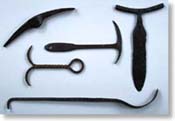 


|
 |
Gold Fever! The Lure and Legacy of the California Gold Rush On
January 24, 1998, exactly one hundred and fifty years after James Marshall's discovery of
gold in California, the Oakland Museum of California opens the largest and most
comprehensive exhibition and investigation of this complex period in America's history: Gold
Fever! The Lure and Legacy of the California Gold Rush. Gold Fever! will
immerse visitors into the sights, sounds and aura of a remarkable era noted for both its
greed and its glory—and the stampede of fortune seekers that poured into California.
This multi-disciplinary exhibition, occupying 10,000 square feet, presents the event's
explosive impact on California's economy, population, environment and cultural diversity
through interactive exhibitions, more than 1,000 artifacts, a theatrical audio guide, film
footage, a reconstructed archaeological dig, conversations with museum docents, and much
more. On
January 24, 1998, exactly one hundred and fifty years after James Marshall's discovery of
gold in California, the Oakland Museum of California opens the largest and most
comprehensive exhibition and investigation of this complex period in America's history: Gold
Fever! The Lure and Legacy of the California Gold Rush. Gold Fever! will
immerse visitors into the sights, sounds and aura of a remarkable era noted for both its
greed and its glory—and the stampede of fortune seekers that poured into California.
This multi-disciplinary exhibition, occupying 10,000 square feet, presents the event's
explosive impact on California's economy, population, environment and cultural diversity
through interactive exhibitions, more than 1,000 artifacts, a theatrical audio guide, film
footage, a reconstructed archaeological dig, conversations with museum docents, and much
more.
Many of the stories told in
Gold Fever! will be new to those who learned about the Gold Rush only from
elementary school textbooks or a casual tour of Sutter's Mill. Applying new research, the
exhibition seeks to inform the visitor by exposing stereotypes, revealing untold stories,
illuminating new truths and calculating the event's lasting impact. Authentic objects,
papers, and photographs document the simultaneous triggering of extraordinary fortunes for
some and utter catastrophes for many others, including California's Native Americans and
Californios. The displays, natural specimens and photographs also vividly present the
staggering effect of mining techniques on California's natural resources and the
consequent birth of the conservation movement.
"The
150th anniversary of the Gold Rush is an ideal time to go back and expose its stereotypes,
bring forth new discoveries, look at its legacy, and explore what it means for us
today," said L. Thomas Frye, Gold Fever! project director. "The
Gold Rush lured the world to California in a frenzy. What happened to California and to
the people who were thrown together here by this accident of fate is the story of this
exhibition."
Visitors will begin their Gold
Fever! tour with a look at nuggets, ingots, coins, jewelry and other artifacts
from around the world that represent the compelling symbolism of gold in human history.
They will then enter an archaeological "dig" filled with a vast array of 1850s
goods, many found in partially burned ships, piers and buildings below San Francisco,
including remarkably preserved jars of Gold-Rush olives.
A second area will present
those who were living in California on the eve of the Gold Rush, native peoples,
Californios, Russians and others. Visitors will then be able to immerse themselves in the
events surrounding the moment of discovery of gold by James Marshall in the mill race at
Sutter's Mill in 1848, and pick up newspaper accounts of the extraordinary riches of the
first finds.
Tableaux of miners' lives
and those who arrived to exploit other opportunities will vividly depict the experiences
of the men, women and children—Anglo Americans, African Americans, Chinese,
Europeans, Mexicans, Chileans, Hawaiians, and more—who made the difficult journey and
took up residence in the gold fields and burgeoning cities under arduous living
conditions. "Our cultural diversity did not happen yesterday," Frye says.
"It goes back 150 years in its greatest dimension. It has enabled California to grow
and prosper as no other state in the union has."
A personal audio guide,
developed by Antenna Theater, will use an innovative theatrical approach, with actors
presenting passionate, insightful first-person accounts taken from journals and
correspondence of the Gold Rush era to provide visitors with a sense of being present on
the scene.
The staggering impact of
mining on California's environment will be dealt with through objects related to mining
techniques, from panning in streams to the massive destruction of entire hillsides with
enormous hydraulic nozzles that blasted away mountains, silting up California's rivers for
miles downstream and flooding prime agriculture land and towns.
Finally, the exhibition
will examine the continuing legacy of the Gold Rush. "If we open our eyes, we can
enjoy the wonderful metaphor of a golden California, and identify with the bold
entrepreneurs who struck it rich in mines or in capital endeavors," Frye says.
"But we also need to look at the Gold Rush in a new light. The real challenge is to
examine both the winners and losers, and to look inward at ourselves and think of
California's future, our own cultural value systems and our need to preserve the golden
land that sustains us."
Gold Fever!
will be on view through July 26, 1998. It will travel to the Autry Museum of Western
Heritage in Los Angeles (September 19, 1998 - January 24, 1999) and to the Sacramento
Memorial Auditorium (July 7 - October 31, 1999).
Return to See the Exhibit Table of Contents. |
 |